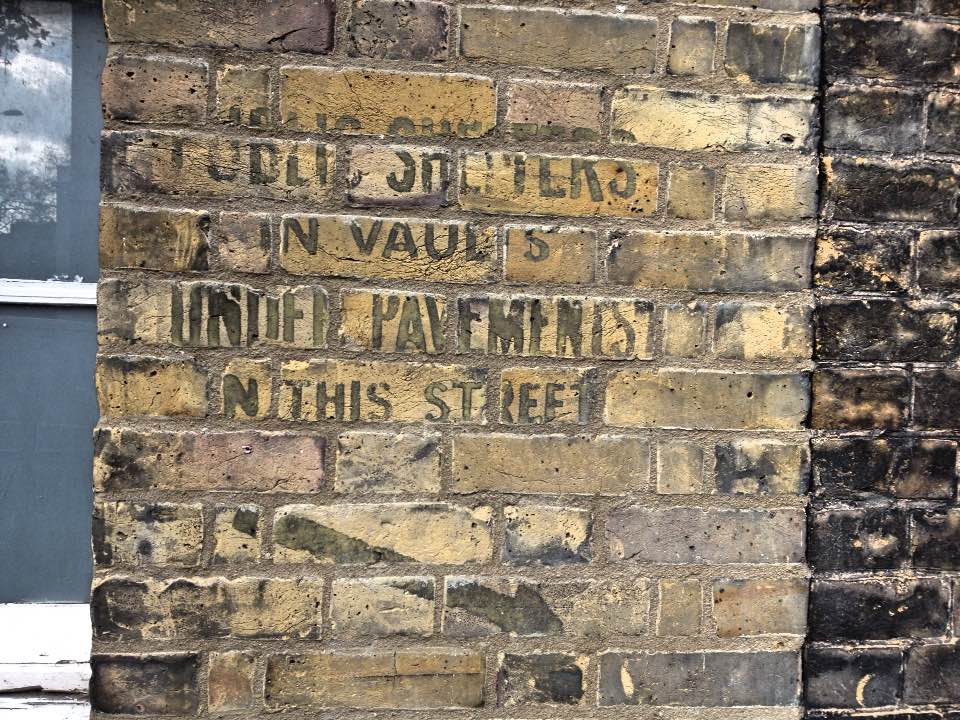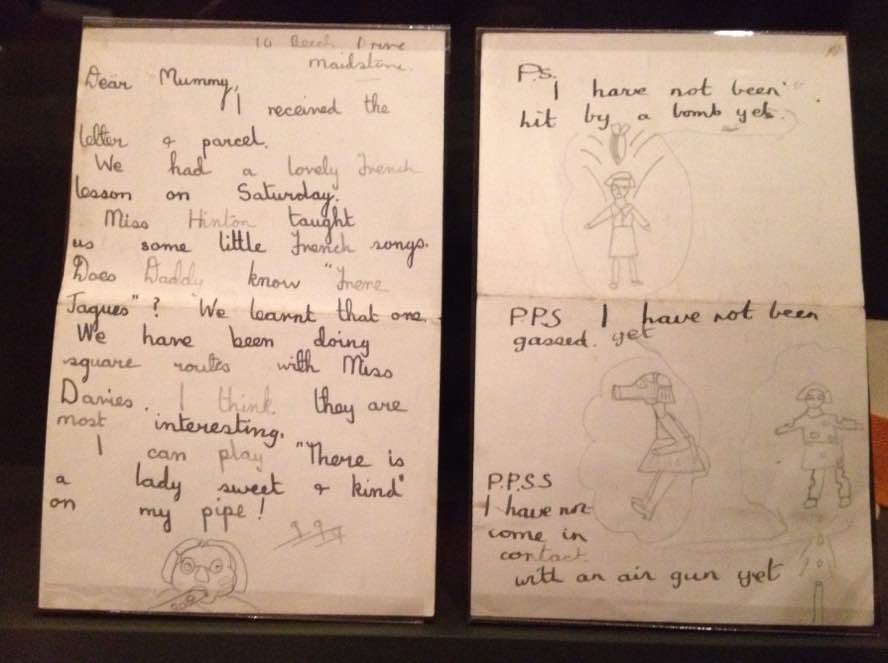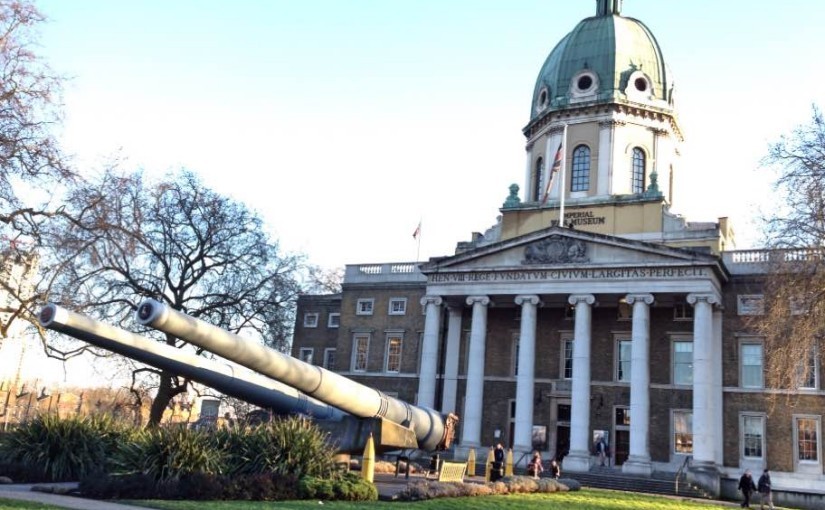A visit to the Imperial War Museum in London has been on the cards for some time but we wanted to wait until the children were old enough to understand and appreciate it. They’ve both learnt about the Second World War at school now so during half-term we combined the museum with a trip round London to view some of the other war legacies.
If you’re interested in a similar exploration I’ve listed below the places we visited and further suggestions that could be incorporated. I wouldn’t advise following our exact route; I had specific plans for lunch so our itinerary is based as much around our stomachs as World War 2 sites!
Site of the first bomb on the city of London, Fore Street
We started in Moorgate, looking for a plaque which commemorates the first bomb of World War 2 to fall in the City of London. It’s thought that German bombers were heading for an oil refinery along the Thames but dropped them, possibly mistakenly, over the city instead.

Much of the City was rebuilt after the war but it seems to me that it’s being rebuilt again. The whole area around Moorgate Underground station is a building site which made it a little difficult for us to find the plaque. When we finally found Fore Street a construction worker kindly pointed out where to see it (down the end near St Giles Cripplegate Church).
Christ Church Greyfriars
We walked from Moorgate to Christ Church Greyfriars. Almost all churches in the City of London were damaged during the Blitz, including many designed by Christopher Wren after the Great Fire of London. Christ Church was one of eight Wren churches hit on the night of 29th December 1940.

The church was almost completely destroyed although the west tower survived and is now a private house; what an amazing place to live! The remains of the church are a public rose garden, perfect for lunchtime breaks.
St Paul’s Cathedral, just a few minutes from Greyfriars, escaped major damage despite almost all of the surrounding buildings being destroyed. This was mainly due to a group of fire fighters who took special care to protect the cathedral.
World War 2 shelter sign – 36 Longmoore Street
Although the Underground stations famously doubled as air raid shelters during the war many other places were also put to use. These were signed to help the public locate them, some of these are still visible today.
One sign can be found at 36 Longmoore Street. Walking along the road you can see that most of the residents have converted their basements to kitchens. Back in World War 2 public shelters were found in vaults in these basements. We could just make out the writing on one of the walls directing people down the stairs to the shelters.

Whilst trying to find out more history of the street I couldn’t resist a peak at property prices. The relatively modest 3 bedroom houses all appear to be worth upwards of £1.8 million, wow!
Tate Britain bomb damage
Few places in London were immune to bombing damage in the Second World War. Even Tate Britain suffered as you can see from the photos below. I wonder how many people notice this when they visit the galleries?

I popped inside briefly to confirm that we were actually looking at bomb damage and spoke with a helpful assistant. He told us that the gallery was damaged by bombs several times in the war but most of the art was moved to Picadilly Underground tunnels for safe storage (the door key is on display in the gallery).
Imperial War Museum
Our main destination was the Imperial War Museum which covers conflicts from World War I onward. Although we were primarily there for World War 2 we also visited the Great War exhibits and had a brief look around at the more recent collections.
I thought the World War I rooms were by far the best, although busy due to school holidays. In comparison the World War II rooms didn’t seem as comprehensive although there was still plenty to see.

Whilst the children liked the big and obvious military exhibits I preferred the personal aspect of war stories. For this reason I focused on the Family in Wartime exhibition which explored the life of the Allpress family during the Second World War. As well as reading and listening to audio clips about how their lives were affected there was a model of their home and an Anderson shelter.
I enjoyed seeing this letter from an evacuee, particularly the postscripts. I could imagine writing them myself as a child!

We missed the Holocaust exhibition out as it’s only recommended for children aged 14 and older. I’ve read that it’s incredibly moving and sobering; definitely worth a visit on a future trip.
Admiralty Citadel
Our last stop of the day was the Admiralty Citadel. I loved seeing this! The Citadel is one of the ugliest and most out of place buildings you can imagine. It’s ‘hidden’ in full view of the public just off of Horse Guards Parade. Can you imagine this getting planning permission nowadays?

The bomb proof citadel was built as the Admiralty communications centre in 1940 and is linked by tunnels to government buildings. It has a 6 metre thick concrete roof which was laid with a grass lawn to help camouflage it. Take a look at this British Pathé film of the roof grass being cut and raked back in 1950.
The building is still in use today; I’d love to pop in for a nose around!
More World War 2 sites in London
We only scratched the surface during our trip. Other World War 2 sites in central London which I came across during my research are shown below.
Cabinet War Rooms, King Charles Street: the secret underground bunker used by Winston Churchill during Word War II. We had planned to visit this but ran out of time. Entrance charge applies.
HMS Belfast: highly recommended. This floating museum ship shows how life was on board during and after the second world war. Lots of stairs and ladders so not for those with mobility issues. Entrance charge applies.
Churches: All Hallows-by-the-Tower survived the Great Fire of London but was almost destroyed in the Blitz; you can still see lead from the roof which melted during the bombing. St Dunstan-in-the-East was destroyed in the war but the ruins have also been turned into a public garden.
Air raid shelter signs: can be found in Queen Anne’s Gate, Brook Street and Lord North Street
Memorials: The Cenotaph and Monument to the Women of World War II are both on Whitehall. The Animals in War memorial can be found in Brook Gate, Park Lane.
Have I missed any? Let me know if you can suggest other central London World War 2 sites.

My husband would love this trip, he’s ex services and loves a bit of war time history.
I’m fascinated by the damage on the Tate, beautiful battle scars which help to tell its story so well.
I’d have never have realised what the damage on the Tate was without reading about it first, not even something I’d have given a second thought too!
So interesting to do this. In fact, I really should do it as a good history lesson. You’re right though, I’m a long way off before I can take Monkey. We’ve wanted to visit the Cabinet War Rooms for a while now. Great list and one to bookmark
I’m still looking forward to visiting the Cabinet War Rooms at some point too. I had planned to visit but had been very ambitious with the time available.
wow what a cool day trip! history is so fascinating – I loved learning about this kind of thing growing up
Thanks Tianna. I don’t think I appreciated it enough when I was growing up so good to learn about it now.
What a wonderful day out. So much history to learn about! x
Thanks Kim, it was x
Brilliant post. Very interesting. The Citadel looks a weird building.
It is so out of place! I know it was built to help the war effort but I really am amazed it was allowed.
great post! I didn’t know there are so many sites associated with WWII. #the weekly postcard
I didn’t either until I started researching the day out. I had assumed everything had been built over already.
I would love to do this with my children now that they are a bit older and able to understand better. Thanks for a fascinating post #pocolo
Definitely worth waiting until the children are older. I’m glad my two had had a chance to study it at school first to give them context.
Such a great idea to take the kids on a tour of places linked or affected by WW2. When my twins were small my husband used to take them to the Imperial War Museum whenever their grandfather visited. I can see them all loving doing a tour like yours!
It was the first time I’d been to the IWM but my other half had fond memories of visiting it as a child too.
That letter is heartbreaking. “I have not been gassed yet…”
🙁 🙁 🙁
I know, but I think it also shows the resilience of the children.
Really fascinating post Christine. I’m hoping to visit some of these places on my London Museum dash for Sport Relief. I’ll be sure to look around for bomb damage!
Good luck with the museum dash. I think you’ll manage to cover quite a few once you add in the less well known museums.
My hubby really really wants to do this trip. We always seem to be so busy when we are in London I’ll have to see if we can make the time. #mondayescapes
I hope you do manage to visit some of the places. I’d recommend HMS Belfast too; we visited a couple of years ago and really enjoyed it.
Really interesting post and a brilliant idea to get a sense of the cost and damage of war on the city of London. Funnily enough I went past Christ Church the other week when I was visiting the Museum of London – and wondered why half of it was gone – thanks for filling in the gaps. I’ve not been to the Imperial War museum yet – I’m like you though and would take a lot from reading the more personal stories… the letter you took a picture of is so interesting. Thanks for linking to #citytripping
This is such a great idea – I love that there’s so much history in London’s streets, but even living here I don’t think I’ve noticed most of the points you visited. Definitely one to do with my daughter when she’s older. Thanks for linking up with #citytripping
Oh this is very interesting, as your outing could have been designed as a city walk/tour and ending at the Imperial War Museum. I read a post by another blogger on the Cabinet War Rooms which is very interesting as well. Thanks for sharing 🙂 #MondayEscapes
Great post – it’s so important to teach and expose our children to our world’s history – I wish I visited more historical sites with my girls. You’ve inspired me. #citytripping
I have to admit that I have been in the Imperial War Museum but really did not take time to appreciate it properly. Hopefully, when Grace is of an age where she can take it in properly, we will return. What a great review – really concise. #PoCoLo
What a fantastic idea for a post! It’s a great idea to focus on a particular piece of history when visiting a city you know well. I really enjoyed this and will keep to do a similar trail with my two boys. #MondayEscapes
That looks a fab day out and a really hands on way of learning history. I worked in the City for many years and hadn’t seen those Moorgate stops – and yes, isn’t it a building site right now! Thanks for linking up to #PoCoLo
What a fascinating tour of London – I would love to so something similar if I make it to London any time soon. Pinning for future reference!
Another wonderful London historical tour. What fascinating bits and pieces you have dug up. Definitely bookmarked for an appropriate occasion.
The Victoria and Albert also has bomb damage on the Exhibition Road side. I often used to note it as I walked past. Of course, I daresay they moved their stuff into storage too.
Feels a bit grim but yet intriguing at the same time. What a pity to miss the Holocaust exhibition, I would have loved to see it through your post. #CityTripping
Thanks for sharing this on #MondayEscapes – great post
Hi Christine, I think you were right to wait until the children were old enough to appreciate what happened during the war to take them visiting the sites. Living in the converted war damaged church must be quite special, imagine getting up in the morning knowing you are surrounded by a part of history.
The letter from the evacuee child to their Mum is quite heart string pulling. Imagine having to tell your Mum that you haven’t been gassed or hit yet. Hopefully our children will never have to do that.
I wouldn’t have guessed that the damage on the Tate Britain building was bomb damage, quite fascinating!
xx
What a great description of places to visit. We’ve been to Pearl Harbor, but the day to day impact of the War in the US was very different than in London and I think visiting the sites you listed would give my children a greater appreciation of how it affected people’s day to day lives. #Mondayescapes